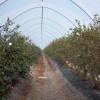 High tunnels have been proposed as an alternative for freeze protection and to increase fruit earliness of southern highbush blueberry. But there is no information about the effect of this type of structure on southern highbush blueberry fruit earliness under subtropical Florida conditions. This 3-page fact sheet summarizes the results of 2-year study in a commercial southern highbush blueberry farm in North Central Florida to compare early fruit weight in high tunnels to that of open fields. This 3-page fact sheet was written by Bielinski M. Santos and Teresa P. Salame-Donoso, and published by the UF Department of Horticultural Sciences, July 2013.
High tunnels have been proposed as an alternative for freeze protection and to increase fruit earliness of southern highbush blueberry. But there is no information about the effect of this type of structure on southern highbush blueberry fruit earliness under subtropical Florida conditions. This 3-page fact sheet summarizes the results of 2-year study in a commercial southern highbush blueberry farm in North Central Florida to compare early fruit weight in high tunnels to that of open fields. This 3-page fact sheet was written by Bielinski M. Santos and Teresa P. Salame-Donoso, and published by the UF Department of Horticultural Sciences, July 2013.
http://edis.ifas.ufl.edu/hs1226
Tag: Bielinski Santos
Integrated Pest Management in Protected Structures I: Basic Principles and Scouting
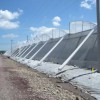 The fundamentals of managing pests in protected structures are very similar in many respects to managing pests in field crops. But conditions within a protected structure can be modified to a certain degree to prevent, delay, or even mitigate pest issues. On the other hand, conditions that discourage one group of pests can often favor another. This 7-page fact sheet was written by Hugh A. Smith, Gary E. Vallad, and Bielinski M. Santos, and published by the UF Department of Entomology and Nematology, June 2013.
The fundamentals of managing pests in protected structures are very similar in many respects to managing pests in field crops. But conditions within a protected structure can be modified to a certain degree to prevent, delay, or even mitigate pest issues. On the other hand, conditions that discourage one group of pests can often favor another. This 7-page fact sheet was written by Hugh A. Smith, Gary E. Vallad, and Bielinski M. Santos, and published by the UF Department of Entomology and Nematology, June 2013.
http://edis.ifas.ufl.edu/in994
Protected Culture for Vegetable and Small Fruit Crops: Types of Structures
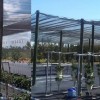 A protective structure is defined as any structure designed to modify the environment in which plants are grown. Protective structures, such as greenhouses, screen houses, and tunnels, are known worldwide as production systems for high-quality vegetable and fruit crops. This 4-page fact sheet was written by Bielinski M. Santos, Gary Vallad, and Emmanuel A. Torres-Quezada, and published by the UF Department of Horticultural Sciences, July 2013.
A protective structure is defined as any structure designed to modify the environment in which plants are grown. Protective structures, such as greenhouses, screen houses, and tunnels, are known worldwide as production systems for high-quality vegetable and fruit crops. This 4-page fact sheet was written by Bielinski M. Santos, Gary Vallad, and Emmanuel A. Torres-Quezada, and published by the UF Department of Horticultural Sciences, July 2013.
http://edis.ifas.ufl.edu/hs1224
'Florida Radiance' Strawberry
 ‘Florida Radiance’ is a strawberry cultivar released from UF/IFAS in 2008. As of 2012, it has become a major cultivar in Florida and other winter and early spring production regions worldwide. In all markets outside the United States and Canada, it is marketed as ‘Florida Fortuna’. In addition to commercial production, it has been tested for many years in field plots at the UF/IFAS Gulf Coast Research and Education Center in Wimauma and the Florida Strawberry Growers Association headquarters in Dover for disease, fruit, and plant traits. This 4-page fact sheet was written by Vance M. Whitaker, Craig K. Chandler, Bielinski M. Santos, and Natalia A. Peres, and published by the UF Department of Horticultural Sciences, June 2013.
‘Florida Radiance’ is a strawberry cultivar released from UF/IFAS in 2008. As of 2012, it has become a major cultivar in Florida and other winter and early spring production regions worldwide. In all markets outside the United States and Canada, it is marketed as ‘Florida Fortuna’. In addition to commercial production, it has been tested for many years in field plots at the UF/IFAS Gulf Coast Research and Education Center in Wimauma and the Florida Strawberry Growers Association headquarters in Dover for disease, fruit, and plant traits. This 4-page fact sheet was written by Vance M. Whitaker, Craig K. Chandler, Bielinski M. Santos, and Natalia A. Peres, and published by the UF Department of Horticultural Sciences, June 2013.
http://edis.ifas.ufl.edu/hs400
Produccion de Hortalizas en Ambientes Protegidos: Medios de Siembra y Contenedores (HS1216)
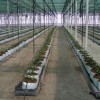 Este documento contiene informacion sobre producción en suelos: Desinfección, mejoramiento, cultivos de cobertura, acolchados (mulches); y tipos de contenedores. This 6-page fact sheet was written by Bielinski M. Santos and Henner A. Obregon-Olivas, and published by the UF Department of Horticultural Sciences, March 2013.
Este documento contiene informacion sobre producción en suelos: Desinfección, mejoramiento, cultivos de cobertura, acolchados (mulches); y tipos de contenedores. This 6-page fact sheet was written by Bielinski M. Santos and Henner A. Obregon-Olivas, and published by the UF Department of Horticultural Sciences, March 2013.
http://edis.ifas.ufl.edu/hs1216
Solutions for Managing Tomato Culls in Florida Tomato Packinghouses (SL371/SS572)
 Florida is the single largest producer of fresh-market tomatoes in the United States. Driven by urbanization and generation of large amounts of tomato culls, tomato packers in Florida often struggle to find ways to dispose of culls generated during the cleaning and sanitizing of tomatoes. This 5-page fact sheet provides guidelines for appropriate management practices to increase the use of culls produced in tomato packinghouses in Florida. Written by Gurpal Toor, Maninder Chahal, and Bielinski Santos, and published by the UF Department of Soil and Water Science, September 2012.
Florida is the single largest producer of fresh-market tomatoes in the United States. Driven by urbanization and generation of large amounts of tomato culls, tomato packers in Florida often struggle to find ways to dispose of culls generated during the cleaning and sanitizing of tomatoes. This 5-page fact sheet provides guidelines for appropriate management practices to increase the use of culls produced in tomato packinghouses in Florida. Written by Gurpal Toor, Maninder Chahal, and Bielinski Santos, and published by the UF Department of Soil and Water Science, September 2012.
http://edis.ifas.ufl.edu/ss572
Protected Culture for Vegetable and Small Fruit Crops: The Soilless Trench System (HS1204)
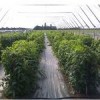 Vegetable and small fruit crop production under protective structures, such as greenhouses, high tunnels, and shade houses, often requires using soilless media to mitigate the impact of soilborne diseases, nematodes, and weeds, and it helps with management of fertilization and irrigation. Regardless of the nature and property of the media, they need to be held in containers to avoid direct contact with the soil or to elevate plants above the ground. An alternative to purchasing containers is building a soilless trench system for production of certain vegetables and small fruit crops. This 3-page fact sheet was written by Bielinski M. Santos and Teresa P. Salame-Donoso, and published by the UF Department of Horticultural Sciences, August 2012.
Vegetable and small fruit crop production under protective structures, such as greenhouses, high tunnels, and shade houses, often requires using soilless media to mitigate the impact of soilborne diseases, nematodes, and weeds, and it helps with management of fertilization and irrigation. Regardless of the nature and property of the media, they need to be held in containers to avoid direct contact with the soil or to elevate plants above the ground. An alternative to purchasing containers is building a soilless trench system for production of certain vegetables and small fruit crops. This 3-page fact sheet was written by Bielinski M. Santos and Teresa P. Salame-Donoso, and published by the UF Department of Horticultural Sciences, August 2012.
http://edis.ifas.ufl.edu/hs1204
Solutions for Managing Wastewater in Florida Tomato Packinghouses (SL372/SS573)
 A large amount of wastewater is produced in Florida's packinghouses during the cleaning and sanitizing of tomatoes. High transportation costs for off-site disposal and strict surface water discharge regulations are critical issues associated with the management of this wastewater. This 4-page fact sheet provides solutions for increasing the reuse of wastewater in tomato packinghouses in Florida. Written by Gurpal Toor, Maninder Chahal, and Bielinski Santos, and published by the UF Department of Soil and Water Science, August 2012.
A large amount of wastewater is produced in Florida's packinghouses during the cleaning and sanitizing of tomatoes. High transportation costs for off-site disposal and strict surface water discharge regulations are critical issues associated with the management of this wastewater. This 4-page fact sheet provides solutions for increasing the reuse of wastewater in tomato packinghouses in Florida. Written by Gurpal Toor, Maninder Chahal, and Bielinski Santos, and published by the UF Department of Soil and Water Science, August 2012.
http://edis.ifas.ufl.edu/ss573
Soil Fumigation after Methyl Bromide: Managing Concentrations of Drip-Applied Metam Potassium for Nutsedge Control (HS1201)
 This 2-page fact sheet presents the results of studies conducted to determine the influence of metam potassium concentrations on purple nutsedge control. Written by Bielinski M. Santos and James P. Gilreath, and published by the UF Department of Horticultural Sciences, April 2012.
This 2-page fact sheet presents the results of studies conducted to determine the influence of metam potassium concentrations on purple nutsedge control. Written by Bielinski M. Santos and James P. Gilreath, and published by the UF Department of Horticultural Sciences, April 2012.
http://edis.ifas.ufl.edu/hs1201
Winterstar(TM) (‘FL 05-107’) Strawberry (HS1198)
 Winterstar(TM) (‘FL 05-107’) is a new strawberry cultivar released from the University of Florida in 2011, originating from a 2005 cross between ‘Florida Radiance’ and ‘Earlibrite’. Data from several years of trials were used to generate this information and recommendations to help growers obtain optimal performance in West Central Florida. This 3-page fact sheet was written by Vance M. Whitaker, Craig K. Chandler, Bielinski M. Santos, and Natalia A. Peres , and published by the UF Department of Horticultural Sciences, April 2012.
Winterstar(TM) (‘FL 05-107’) is a new strawberry cultivar released from the University of Florida in 2011, originating from a 2005 cross between ‘Florida Radiance’ and ‘Earlibrite’. Data from several years of trials were used to generate this information and recommendations to help growers obtain optimal performance in West Central Florida. This 3-page fact sheet was written by Vance M. Whitaker, Craig K. Chandler, Bielinski M. Santos, and Natalia A. Peres , and published by the UF Department of Horticultural Sciences, April 2012.
http://edis.ifas.ufl.edu/hs1198
University of Florida Strawberry Cultivars (HS1199)
 This 4-page fact sheet gives basic descriptions and suggested practices for University of Florida strawberry cultivars that are of commercial importance to the Florida strawberry industry. Descriptions are the result of research trials, field observations, and consultation with growers. They are specific to West Central Florida and may not be applicable to other regions where these cultivars are grown. Written by Vance M. Whitaker, Bielinski M. Santos, and Natalia A. Peres, and published by the UF Department of Horticultural Sciences, April 2012.
This 4-page fact sheet gives basic descriptions and suggested practices for University of Florida strawberry cultivars that are of commercial importance to the Florida strawberry industry. Descriptions are the result of research trials, field observations, and consultation with growers. They are specific to West Central Florida and may not be applicable to other regions where these cultivars are grown. Written by Vance M. Whitaker, Bielinski M. Santos, and Natalia A. Peres, and published by the UF Department of Horticultural Sciences, April 2012.
http://edis.ifas.ufl.edu/hs1199
Cultural Practices for Vegetable and Small Fruit Crops: Using Kaolin Clay to Reduce Sprinkler Irrigation for Strawberry Transplant Establishment (HS1188)
Because of the current limitations on water usage for strawberry growers in the Plant City area of Hillsborough County, researchers at the UF/IFAS Gulf Coast Research and Education center have been looking for inexpensive ways to reduce the amount of sprinkler irrigation in strawberry production. This 3-page fact sheet presents research results on the effect of kaolin clay application on sprinkler irrigation volumes applied to newly transplanted strawberries. It was written by Bielinski M. Santos, Teresa P. Salame-Donoso, Craig D. Stanley, Alicia J. Whidden, Crystal A. Snodgrass, and Mary B. Henry, and published by the UF Department of Horticultural Sciences, December 2010.
http://edis.ifas.ufl.edu/hs1188
HS1186 Solutions for Small Farmers and Home Gardens: Building a Low-Cost Vertical Soilless System for Production of Small Vegetable and Fruit Crops
HS1186, a 5-page illustrated fact sheet by Bielinski M. Santos, Teresa P. Salame-Donoso, and Shawn C. Arango, provides written and graphic instructions on how to build a homemade vertical soilless (hydroponic) growing system (also known as “bottle grow”) to produce vegetables and small fruit crops at a fraction of the cost of commercially available systems, without occupying premium agricultural land and by utilizing materials available in the home and local hardware store. Published by the UF Department of Horticultural Sciences, November 2010.
http://edis.ifas.ufl.edu/hs1186
HS1882 Producción de Hortalizas en Ambientes Protegidos: Estructuras para la Agricultura Protegida
HS1182, a 5-page illustrated, Spanish-language fact sheet by Bielinski M. Santos, Henner A. Obregón-Olivas y Teresa P. Salamé-Donoso, describes the advantages and disadvantages of various types of structures used in protected vegetable production. Published by the UF Department of Horticultural Sciences, August 2010.
http://edis.ifas.ufl.edu/hs1182
HS1180 Cultural Practices for Vegetable and Small Fruit Crops: Does Shoot Pruning Improve Tomato Yield and Reduce Bacterial Spot Infestation?
HS1180, a 4-page illustrated fact sheet by Bielinski M. Santos and Gary E. Vallad, examines the effectiveness of shoot pruning to control bacterial spot infestation and improve yield of tomato. Published by the UF Department of Horticultural Sciences, July 2010.
http://edis.ifas.ufl.edu/hs1180
HS1162/HS407 Protected Culture for Vegetable and Small Fruit Crops: High Tunnels for Strawberry Production in Florida
HS1162, a 4-page illustrated fact sheet by Bielinski M. Santos, Teresa P. Salamé-Donoso, Craig K. Chandler, and Steven A. Sargent, presents the results of research comparing the effects of high-tunnel and open-field production on the growth, fruit earliness, and yield of strawberry cultivars in Florida. Published by the UF Department of Horticultural Sciences, March 2010.
http://edis.ifas.ufl.edu/hs407
HS1160 Prácticas Culturales para la Producción Comercial de Fresas en Florida
HS1160, a 15-page illustrated Spanish language fact sheet by Bielinski M. Santos y Henner A. Obregón, describes strawberry production in Florida, its history, cultivar development and cultural practices. Published by the UF Department of Horticultural Sciences, October 2009.
http://edis.ifas.ufl.edu/HS1160
HS1156 Review of Nutrient Management Systems for Florida Vegetable Producers
HS1156, a 17-page white paper from the UF/IFAS Vegetable Fertilizer Task Force, identifies differences between actual fertilization practices and UF/IFAS fertilizer recommendations, especially for vegetables grown with subsurface (Central and South Florida) and overhead (Miami-Dade County) irrigation. The recommendations of the VFTF aim at bridging the gaps between science-based results and the diversity in production systems found in the Florida vegetable industry. Includes references. Published by the UF Department of Horticultural Sciences, April 2009.
http://edis.ifas.ufl.edu/HS1156
HS1150/HS399 ‘Florida Elyana’ Strawberry
HS-1150, a 2-page illustrated fact sheet by C.K. Chandler, B.M. Santos, and N.A. Peres, describes the performance of this short-cultivar that has shown promise in recent trials in western portions of Central Florida. Includes references. Published by the UF Department of Horticultural Sciences, December 2008.
http://edis.ifas.ufl.edu/HS399
HS1154/HS403 Growing Strawberries in the Florida Home Garden
HS-1154, a 4-page illustrated fact sheet by Craig K. Chandler, James F. Price, Natalia A. Peres, and Bielinski M. Santos, provides home gardeners with information about strawberry growing conditions and varieties for Florida, soil preparation and plant establishment, freeze protection, pest management, and harvesting and storage. It replaces HS509/VH029, Strawberries in the Florida Garden, by James M. Stephens. Published by the UF Department of Horticultural Sciences, December 2008.
http://edis.ifas.ufl.edu/HS403